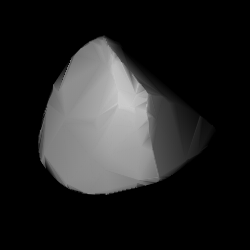Astronomy:3962 Valyaev
 Shape model of Valyaev from its lightcurve | |
| Discovery [1] | |
|---|---|
| Discovered by | T. Smirnova |
| Discovery site | Crimean Astrophysical Obs. |
| Discovery date | 8 February 1967 |
| Designations | |
| (3962) Valyaev | |
| Named after | Valerij Valyaev (Russian astronomer)[2] |
| 1967 CC · 1973 GL1 1976 UT10 · 1982 XE1 1984 DC2 | |
| Minor planet category | main-belt · Themis [3] |
| Orbital characteristics [1] | |
| Epoch 4 September 2017 (JD 2458000.5) | |
| Uncertainty parameter 0 | |
| Observation arc | 60.92 yr (22,251 days) |
| |{{{apsis}}}|helion}} | 3.5778 AU |
| |{{{apsis}}}|helion}} | 2.8406 AU |
| 3.2092 AU | |
| Eccentricity | 0.1148 |
| Orbital period | 5.75 yr (2,100 days) |
| Mean anomaly | 293.47° |
| Mean motion | 0° 10m 17.04s / day |
| Inclination | 1.9984° |
| Longitude of ascending node | 49.683° |
| 106.16° | |
| Physical characteristics | |
| Mean diameter | 14.76±1.11 km[4] 16.285±0.231 km[5][6] |
| Rotation period | 16.4399±0.0077 h[3][7] |
| Geometric albedo | 0.08 (assumed)[3] 0.088±0.014[5][6] 0.089±0.014[4] |
| C (assumed)[3] | |
| Absolute magnitude (H) | 12.2[5] · 12.4[1][4] · 12.403±0.005 (R)[7] · 12.56±0.19[8] · 12.85[3] |
3962 Valyaev (prov. designation: 1967 CC) is a dark Themistian asteroid from the outer region of the asteroid belt. The presumed C-type asteroid has a rotation period of 16.4 hours and measures approximately 15 kilometers (9.3 miles) in diameter. It was discovered on 8 February 1967, by Russian astronomer Tamara Smirnova at Nauchnyj on the Crimean peninsula, and later named after Russian astronomer Valerij Valyaev.[2][9]
Classification and orbit
The C-type asteroid is a member of the Themis family, a dynamical family of outer-belt asteroids with nearly coplanar ecliptical orbits. It orbits the Sun at a distance of 2.8–3.6 AU once every 5 years and 9 months (2,100 days). Its orbit has an eccentricity of 0.11 and an inclination of 2° with respect to the ecliptic.[1] A first precovery was obtained at Palomar Observatory in 1956, extending the asteroid's observation arc by 11 years prior to its discovery.[9]
Naming
This minor planet was named after Russian astronomer Valerij Valyaev (b. 1944), chief of the Ephemeris Astronomy Department at the Institute for Theoretical Astronomy (ITA), which was then part of the USSR Academy of Sciences in Leningrad. The minor planet 1735 ITA is named after this institute. Valyaev is also the senior editor of the periodicals Morskoj Astronomicheskij Ezhegodnik and Aviatsionnyj Astronomicheskij Ezhegodnik. The asteroids's name was proposed by ITA,[2] and its official naming citation was published by the Minor Planet Center on 18 December 1994 (M.P.C. 24410).[10]
Physical characteristics
Rotation period
In September 2010, a rotational lightcurve of Valyaev was obtained from photometric observations by the Palomar Transient Factory survey in California. Lightcurve analysis gave a rotation period of 16.4399 hours with a brightness amplitude of 0.44 magnitude ({{{1}}}).[7]
Diameter and albedo
According to the surveys carried out by the Japanese Akari satellite and the NEOWISE mission of NASA's Wide-field Infrared Survey Explorer, Valyaev measures 14.76 and 16.3 kilometers in diameter and its surface has a low albedo of 0.088 and 0.089, respectively.[4][5][6] The Collaborative Asteroid Lightcurve Link (CALL) assumes an albedo for carbonaceous asteroids of 0.08 and calculates a smaller diameter of 12.6 kilometers with an absolute magnitude of 12.85.[3]
References
- ↑ 1.0 1.1 1.2 1.3 "JPL Small-Body Database Browser: 3962 Valyaev (1967 CC)". Jet Propulsion Laboratory. https://ssd.jpl.nasa.gov/sbdb.cgi?sstr=2003962.
- ↑ 2.0 2.1 2.2 Schmadel, Lutz D. (2007). "(3962) Valyaev". Dictionary of Minor Planet Names. Springer Berlin Heidelberg. p. 338. doi:10.1007/978-3-540-29925-7_3950. ISBN 978-3-540-00238-3.
- ↑ 3.0 3.1 3.2 3.3 3.4 3.5 "LCDB Data for (3962) Valyaev". Asteroid Lightcurve Database (LCDB). http://www.minorplanet.info/PHP/generateOneAsteroidInfo.php?AstInfo=3962%7CValyaev.
- ↑ 4.0 4.1 4.2 4.3 Usui, Fumihiko; Kuroda, Daisuke; Müller, Thomas G.; Hasegawa, Sunao; Ishiguro, Masateru; Ootsubo, Takafumi et al. (October 2011). "Asteroid Catalog Using Akari: AKARI/IRC Mid-Infrared Asteroid Survey". Publications of the Astronomical Society of Japan 63 (5): 1117–1138. doi:10.1093/pasj/63.5.1117. Bibcode: 2011PASJ...63.1117U. (online, AcuA catalog p. 153)
- ↑ 5.0 5.1 5.2 5.3 Mainzer, A.; Grav, T.; Masiero, J.; Hand, E.; Bauer, J.; Tholen, D. et al. (November 2011). "NEOWISE Studies of Spectrophotometrically Classified Asteroids: Preliminary Results". The Astrophysical Journal 741 (2): 25. doi:10.1088/0004-637X/741/2/90. Bibcode: 2011ApJ...741...90M. http://adsabs.harvard.edu/cgi-bin/bib_query?bibcode=2011ApJ...741...90M. Retrieved 26 April 2016.
- ↑ 6.0 6.1 6.2 Masiero, Joseph R.; Mainzer, A. K.; Grav, T.; Bauer, J. M.; Cutri, R. M.; Dailey, J. et al. (November 2011). "Main Belt Asteroids with WISE/NEOWISE. I. Preliminary Albedos and Diameters". The Astrophysical Journal 741 (2): 20. doi:10.1088/0004-637X/741/2/68. Bibcode: 2011ApJ...741...68M. http://adsabs.harvard.edu/cgi-bin/bib_query?bibcode=2011ApJ...741...68M. Retrieved 5 December 2016.
- ↑ 7.0 7.1 7.2 Waszczak, Adam; Chang, Chan-Kao; Ofek, Eran O.; Laher, Russ; Masci, Frank; Levitan, David et al. (September 2015). "Asteroid Light Curves from the Palomar Transient Factory Survey: Rotation Periods and Phase Functions from Sparse Photometry". The Astronomical Journal 150 (3): 35. doi:10.1088/0004-6256/150/3/75. Bibcode: 2015AJ....150...75W. http://adsabs.harvard.edu/cgi-bin/bib_query?bibcode=2015AJ....150...75W. Retrieved 26 April 2016.
- ↑ Veres, Peter; Jedicke, Robert; Fitzsimmons, Alan; Denneau, Larry; Granvik, Mikael; Bolin, Bryce et al. (November 2015). "Absolute magnitudes and slope parameters for 250,000 asteroids observed by Pan-STARRS PS1 - Preliminary results". Icarus 261: 34–47. doi:10.1016/j.icarus.2015.08.007. Bibcode: 2015Icar..261...34V. http://adsabs.harvard.edu/cgi-bin/bib_query?bibcode=2015Icar..261...34V. Retrieved 26 April 2016.
- ↑ 9.0 9.1 "3962 Valyaev (1967 CC)". Minor Planet Center. https://www.minorplanetcenter.net/db_search/show_object?object_id=3962.
- ↑ "MPC/MPO/MPS Archive". Minor Planet Center. https://www.minorplanetcenter.net/iau/ECS/MPCArchive/MPCArchive_TBL.html.
External links
- Lightcurve Database Query (LCDB), at www.minorplanet.info
- Dictionary of Minor Planet Names, Google books
- Asteroids and comets rotation curves, CdR – Geneva Observatory, Raoul Behrend
- Discovery Circumstances: Numbered Minor Planets (1)-(5000) – Minor Planet Center
- 3962 Valyaev at AstDyS-2, Asteroids—Dynamic Site
- 3962 Valyaev at the JPL Small-Body Database
 |

